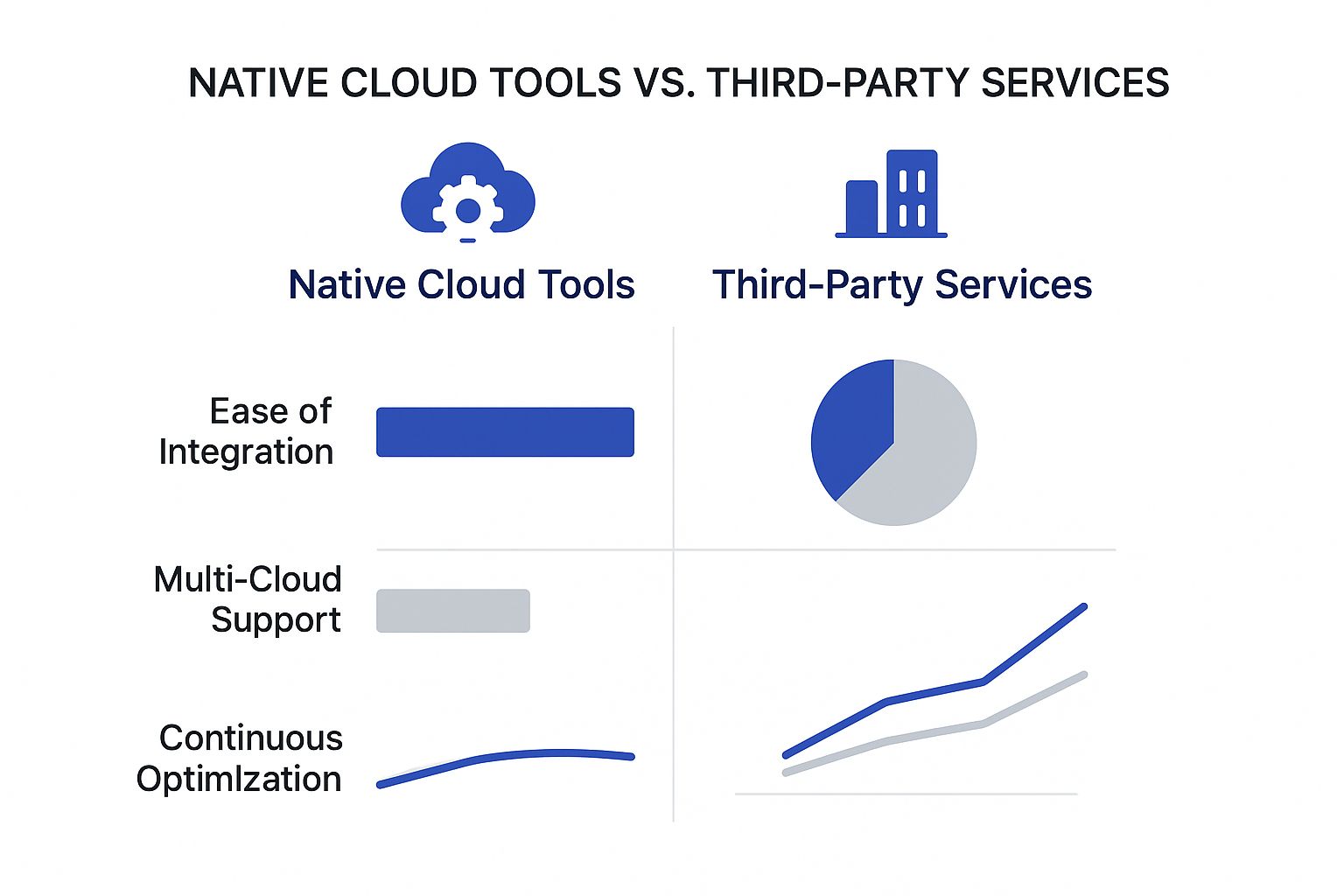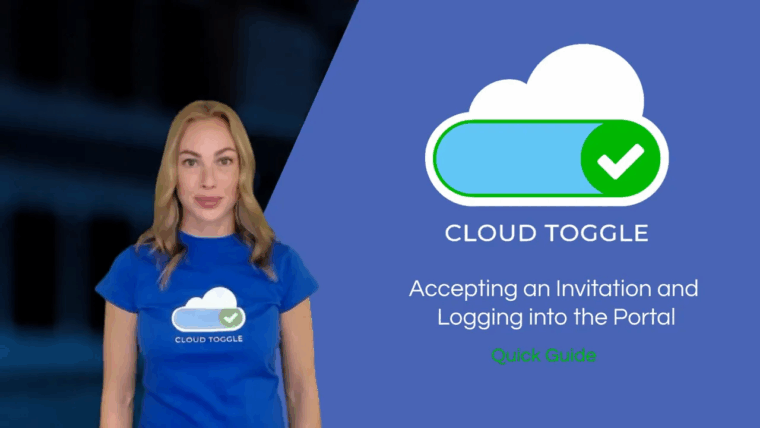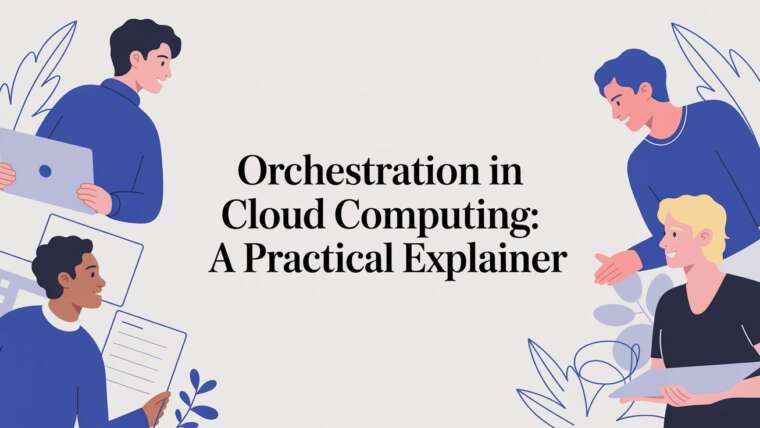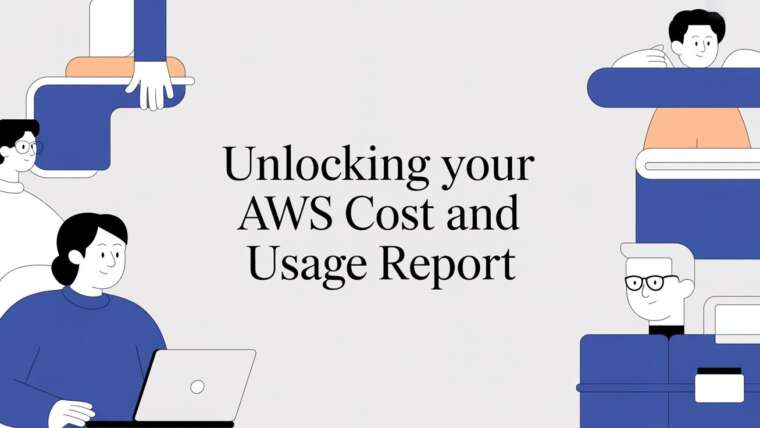Think of cloud computing management services as the specialised expertise you bring in to oversee and fine-tune your entire cloud setup. They essentially act as a dedicated operations team for your cloud environment. They handle everything from cost control and security to performance monitoring and daily upkeep, which frees up your in-house teams to focus on what they do best: driving the business forward.
What Exactly Are Cloud Management Services?

Let's use an analogy. Imagine your cloud environment is a high-performance orchestra. You've got all the instruments (servers, storage, databases, and networks) but you need a skilled conductor to make them all play in perfect harmony. Without one, the music can quickly become chaotic, jarring, and incredibly expensive.
Cloud computing management services are that conductor. They bring order, strategy, and deep expertise to your cloud operations. Their main job is to lift the immense operational weight of day-to-day cloud maintenance right off your shoulders. This lets your business get all the benefits of the cloud without getting tangled up in its complexities.
The Core Purpose of Cloud Management
At its heart, cloud management is all about bridging the gap between the powerful, raw tools offered by cloud providers like AWS and Azure, and the practical skills needed to use them well. So many organisations move to the cloud expecting simplicity, only to find themselves drowning in sprawling resources and unpredictable bills. This is precisely where a management service steps in.
They provide a structured framework for controlling, administering, and improving your entire cloud footprint. This boils down to a few critical jobs:
- Cost Optimisation: Actively hunting down and eliminating wasteful spending. This could mean shutting down idle servers or rightsizing oversized resources to make sure you only pay for what you actually need.
- Security and Compliance: Putting robust security protocols in place, constantly monitoring for threats, and ensuring your whole setup meets the necessary industry and regional compliance standards.
- Performance Monitoring: Proactively keeping an eye on your applications and infrastructure health. The goal is to spot problems before they cause downtime and ensure a smooth experience for your users.
- Automation and Efficiency: Automating all the routine but critical tasks like backups, patching, and provisioning new resources. This cuts down on manual effort and dramatically reduces the risk of human error.
Why It Matters for Your Business
Let's be blunt: without proper management, a cloud environment can quickly become a black hole for money and manpower. Studies consistently show that a huge chunk of cloud spending is wasted on underutilised resources. Cloud computing management services are specifically designed to plug that leak. They provide the oversight needed to turn a reactive, often chaotic cloud setup into a proactive, predictable, and cost-effective business asset.
A well-managed cloud environment isn't just an IT advantage; it's a competitive differentiator. It ensures your technology foundation is secure, efficient, and perfectly aligned with your strategic objectives, allowing you to innovate faster and serve customers better.
By taking care of the intricate technical details, these services empower your internal teams to stop worrying about infrastructure maintenance and start focusing on innovation. If you want to dive deeper, you can find a wealth of information about effective cloud management strategies and best practices. Ultimately, it sets the stage for a more agile and resilient business operation.
Deconstructing the Core Components of Cloud Management

To really get what cloud computing management services bring to the table, it helps to look under the bonnet. These services aren't just a single product; they're a collection of essential functions, each tackling a specific, often painful, challenge of running a business in the cloud. Think of them less as abstract features and more as practical tools that deliver real business results.
At their heart, these core components work together to form a safety net, making sure your cloud environment is powerful, secure, and doesn't drain your budget. Each function is designed to solve a common headache that nearly every organisation feels as its cloud presence grows.
The UK cloud market is booming, hitting an estimated £27.48 billion in 2024 and projected to climb to almost £97.21 billion by 2033. With that kind of growth, having a firm grip on your cloud estate isn't just good practice. It's essential for staying competitive.
H3: Proactive Performance Monitoring
One of the biggest jobs of any cloud management service is keeping a constant, watchful eye on performance. This is so much more than a simple "is it on or off?" check. It's about digging into the details: application response times, CPU usage, memory, and network lag, all to ensure everything is running just as it should be.
Picture your e-commerce site on Black Friday. A good management service will spot a performance bottleneck in real-time. It might automatically scale up your resources to handle the surge in traffic long before your customers notice a hint of sluggishness. That's the difference between a record sales day and a frustrating, revenue-losing outage.
This level of oversight shifts your IT operations from a reactive, firefighting mode to a proactive, preventative one.
Effective monitoring is the difference between finding out about a problem from an angry customer and resolving it before it ever impacts anyone. It is the bedrock of a reliable and high-performing cloud infrastructure.
H3: Robust Security and Compliance
Security isn't something you set up once and forget about. It’s a continuous process of staying vigilant. Cloud management services are your front line, implementing and maintaining a strong security posture across everything you run in the cloud. This means managing firewalls, patching vulnerabilities as they appear, controlling who has access to what, and constantly scanning for threats.
Then there's the minefield of compliance with regulations like GDPR. Management services are a huge help here, typically by:
- Configuring Environments: Setting up your cloud resources from day one to meet specific regulatory rules.
- Continuous Auditing: Regularly checking for compliance gaps and generating the reports you need to prove you're following the rules.
- Data Governance: Putting policies in place to make sure sensitive data is handled securely and correctly.
These actions are critical for avoiding the hefty fines and reputational damage that come from security breaches or compliance failures.
H3: Strategic Cost Optimisation
Let's be honest: without careful management, cloud bills can get out of control, fast. Strategic cost optimisation is often the most immediately impactful part of cloud computing management services. Experts use specialised tools to comb through your spending, spotting waste you might not even know is there.
A classic example is finding idle resources, like virtual machines left running over the weekend when nobody is using them. They also hunt for "oversized" instances, servers that have far more power (and cost) than they actually need, and recommend switching to a cheaper alternative without hurting performance. This "right-sizing" can lead to massive monthly savings. To get a better sense of this, you can learn more about the hidden cost of idle VMs and see how simple scheduling can save thousands.
It’s all about a disciplined approach to make sure you get the most value from every pound you spend.
H3: Intelligent Automation
Finally, intelligent automation is the engine that makes everything more efficient. Cloud management platforms automate the repetitive, manual jobs that eat up your IT team's time. This can be anything from spinning up new servers and databases to running routine backups and applying software patches.
By taking these tasks off your team's plate, automation cuts down on the risk of human error, speeds up operations, and frees up your talented engineers to work on projects that actually move the business forward. It's a fundamental shift from manual tinkering to automated operations. This is a key step in building a truly agile and scalable business.
The Strategic Benefits of a Managed Cloud Service
Bringing in a managed cloud service is about more than just outsourcing your IT. It’s about making a strategic decision to turn your cloud infrastructure from a simple utility into a real competitive advantage. The focus shifts from wrestling with technical configurations to achieving business goals that directly impact your bottom line, security, and ability to adapt.
Think of it as transforming your cloud from a necessary cost centre into a powerful engine for growth. One of the biggest wins is getting instant access to a team of seasoned cloud experts. You skip the headache and high cost of trying to hire and retain that kind of specialised talent in-house, which is a real challenge in today's market.
Just look at the UK cloud computing market. Valued at roughly USD 56.08 billion in 2025, it's projected to rocket forward at a 16.1% CAGR to hit nearly USD 118.29 billion by 2030. That kind of explosive growth means more complexity, making expert management more critical than ever. You can dig into the trends shaping the UK cloud market to see what’s fuelling this demand.
Achieving Ironclad Security and Compliance
In a world where digital threats are a constant reality, having a solid security posture isn't optional. It's essential. A good managed service provider acts as your dedicated security guardian. They’re the ones implementing advanced threat detection, managing firewalls, and making sure every part of your setup is hardened against attack. Crucially, they stay ahead of the curve, proactively patching the latest vulnerabilities before they can be exploited.
Take a fintech company, for example. They handle incredibly sensitive customer data and simply can't afford a single security slip-up. A managed service doesn't just secure their cloud environment; it ensures it's constantly audited to meet strict regulations like GDPR. That delivers peace of mind and builds the kind of trust that customers demand.
Unlocking Substantial Cost Savings
One of the most compelling reasons to partner with a cloud computing management service is the very real potential for serious cost savings. These providers aren't just glancing at your monthly bill. They use sophisticated tools to constantly analyse your cloud spend, rooting out and eliminating the kind of waste that often flies under the radar.
A managed service transforms cost management from a reactive, monthly bill review into a proactive, continuous optimisation process. It ensures every pound spent on the cloud delivers maximum value to the business.
This isn't a one-off fix; it's an ongoing discipline built on a few key actions:
- Rightsizing Resources: They analyse your actual workload patterns to make sure your virtual machines and databases aren't overprovisioned. This is one of the most common ways money gets wasted.
- Scheduling Idle Assets: Development and testing environments don't need to run 24/7. They automate shutdowns during nights and weekends, immediately cutting costs.
- Optimising Storage Tiers: Data that isn't accessed frequently gets moved to cheaper storage options, without you ever losing the ability to get to it when you need it.
These practices bring financial discipline to your cloud operations. For a much deeper dive, check out our guide on what cloud cost management is and how to do it.
Boosting Operational Efficiency with Automation
Repetitive, manual IT tasks are a killer for productivity and team morale. Managed services bring in smart automation to take over the relentless jobs like provisioning servers, patching software, and running data backups. Not only does this automation standardise your processes and slash the risk of human error, but it also frees your skilled engineers to work on projects that actually move the business forward.
Picture a retail business gearing up for a big seasonal sale. Instead of having a team spend hours manually configuring and deploying dozens of servers, a managed service uses automation to spin up the entire environment in minutes. Once the sale is over, that same automation scales everything back down. They only paid for what they needed, when they needed it. This agility allows their in-house team to focus on improving the customer experience instead of getting bogged down in infrastructure management.
Choosing Between Native Cloud Tools and Third Party Services
One of the biggest decisions you’ll make when managing your cloud setup is which tools to use. Should you stick with the native tools offered directly by your provider, like AWS, Azure, and Google Cloud, or bring in a specialised third party service?
There’s no single right answer. Each path has its own set of advantages and challenges, and the best choice really boils down to your business needs, your team's skills, and your long-term goals. This isn't just a tech decision; it directly impacts your budget, how efficiently you operate, and how easily you can grow.
The Case for Native Cloud Tools
Cloud giants like AWS, Azure, and Google Cloud don't just sell you infrastructure; they give you a whole toolbox to manage it. Think of services like AWS CloudWatch, Azure Monitor, or Google Cloud's Operations Suite. The biggest draw here is seamless integration. These tools are built from the ground up to work perfectly within their own world.
If your business lives entirely on a single cloud, this can look very appealing. The tools are right there in the console, often with a lower initial cost, making them seem like the most wallet-friendly option. They offer a solid foundation for monitoring, basic automation, and security, all straight from the source.
But that convenience comes at a price. Native tools can have a steep learning curve. To get the most out of them, your team needs to become experts in that specific platform's quirks. What’s more, their greatest strength (deep integration) is also their biggest weakness. They're designed for their own sandbox and offer little to no visibility into what's happening on a competitor's platform.
The Power of Third Party Management Services
This is exactly where third party cloud computing management services step in. Their whole purpose is to give you a single pane of glass to manage everything, no matter where it’s running. With 63% of businesses now using a multi-cloud strategy, this is a massive advantage. Instead of juggling multiple consoles, you get one central hub.
These providers offer more than just a unified dashboard; they bring dedicated expertise to the table. Their entire business is cloud management, so they often provide more advanced automation, deeper cost-saving features, and more sophisticated security than you'd get from native tools alone.
Partnering with a third party provider transforms cloud management from a collection of siloed, platform-specific tasks into a unified, strategic operation. It provides the visibility and control needed to manage a complex multi-cloud environment effectively.
Yes, there's usually an extra subscription cost, but the return on investment often comes from finding savings you didn't know you were missing. By spotting waste across all your clouds and automating complex optimisation tasks, these services can easily pay for themselves.
The infographic below shows just how different the two approaches are when it comes to integration, multi-cloud support, and optimisation.

As you can see, while native tools are great for single-cloud setups, third party services deliver the crucial multi-cloud support and continuous optimisation that modern businesses demand.
Let’s break down the key differences.
Native Cloud Tools vs Third Party Management Services
| Aspect | Native Cloud Tools (e.g., AWS CloudWatch, Azure Monitor) | Third Party Management Services |
|---|---|---|
| Primary Focus | Deep integration within a single cloud ecosystem. | Unified management across multiple clouds (multi-cloud/hybrid). |
| Multi-Cloud Support | Limited or non-existent. Designed for its own platform. | Core feature. Provides a single dashboard for all resources. |
| Expertise Required | High level of platform-specific knowledge is needed. | More user-friendly. Offloads much of the deep expertise to the provider. |
| Feature Set | Solid foundational tools for monitoring, security, and basic automation. | Often includes more advanced automation, cost optimisation, and security features. |
| Cost Structure | Lower initial cost, often bundled with the cloud subscription. | Typically a separate subscription fee, but can lead to greater overall savings. |
| Best For | Businesses committed to a single cloud provider with in-house expertise. | Businesses with multi-cloud or hybrid strategies, or lean teams needing to offload management tasks. |
This table highlights the fundamental trade-off: the deep, native integration of provider tools versus the broad, simplifying power of a third party platform.
Making the Right Decision for Your Business
So, how do you pick? Your specific situation will point you in the right direction.
Here's a quick way to think it through:
- Assess Your Cloud Strategy: Are you all-in on a single provider? If so, and you have a team of experts on that platform, native tools might be enough.
- Evaluate Your Team's Bandwidth: If your team is stretched thin or you want them focused on building products, a third party service can be a huge help by taking on the operational load.
- Analyse Your Complexity: Running a multi-cloud or hybrid environment? A third party platform is almost a necessity for staying sane. The unified view is critical for managing costs and security across the board.
- Consider Your Growth Plans: If you see yourself scaling or adding another cloud provider down the road, starting with a third party service now will make that transition much smoother.
Ultimately, you want a solution that lines up with your business goals, empowers your team, and gives you the control needed to turn your cloud environment into a powerful, cost-effective asset.
How to Select the Right Cloud Management Provider

Choosing the right partner for your cloud computing management services is a big deal. It feels like a high-stakes decision because, frankly, it is. With so many providers out there all promising the world, it's easy to get lost in a sea of technical jargon. The real trick is to cut through that noise and focus on what actually matters for your business.
This isn’t just about finding another vendor. You're looking for a strategic partner who will basically become an extension of your own team. You need someone deeply invested in your infrastructure's performance, security, and costs. A bit of method to the madness is essential to make a choice you feel good about.
The UK cloud market is absolutely booming. In 2024, its revenue hit around USD 47.24 billion, and forecasts suggest it could jump to a staggering USD 135.24 billion by 2030. This explosive growth means a flood of providers, making a structured evaluation more critical than ever. You can get more details on the accelerating UK cloud market and who the key players are.
Verify Technical Expertise and Certifications
First things first, you need to be sure a potential provider has the technical chops to handle your specific setup. Don't just take their marketing spiel for it; look for cold, hard proof. This means checking for official certifications from the big players like AWS, Microsoft Azure, and Google Cloud.
These certifications aren't just fancy badges. They prove the provider's team has passed tough exams and genuinely understands the platform's best practices. Ask them directly about their team's experience with the services you rely on, whether that’s container orchestration with Kubernetes or handling tricky database migrations.
A provider with real technical depth can offer proactive advice, not just reactive fixes. They'll help steer your architectural decisions and help you sidestep common traps that lead to poor performance or a surprisingly massive bill.
Scrutinise Security and Compliance Credentials
In an age of constant cyber-threats and strict data laws, security can't be an afterthought. Your chosen provider must show a rock-solid commitment to locking down your cloud infrastructure. Ask them detailed questions about their security protocols, how they spot threats, and what their incident response plan looks like.
For any business operating in the UK, complying with regulations like GDPR isn't optional. A potential partner should be able to spell out exactly how they keep your cloud environment in line with these standards.
Choosing a cloud management provider is like hiring a security guard for your most valuable digital assets. You need to be certain they have the training, tools, and vigilance to protect your data around the clock.
Keep an eye out for providers holding recognised security certifications like ISO 27001 or SOC 2. These credentials show that an independent third party has audited their security practices and given them a stamp of approval against high international standards.
Understand Support Models and SLAs
When something inevitably goes wrong, you need to know exactly what kind of support you can count on. This is where Service Level Agreements (SLAs) are absolutely vital. An SLA is the formal contract that lays out the provider’s promises on service uptime, performance, and response times.
Don't just skim it. Read the SLA carefully to understand the nitty-gritty:
- Support Availability: Is support available 24/7, or are you on your own after 5 p.m.?
- Response Times: How quickly will they acknowledge and start working on issues of different severities?
- Resolution Targets: Are there actual deadlines for getting problems fixed?
- Communication Channels: How do you get in touch? Phone, email, a dedicated portal?
A vague SLA is a huge red flag. A great provider will offer a clear, measurable agreement that gives you real confidence in their ability to back you up when you need them most.
Ask the Right Questions
To finish your evaluation, go in armed with a list of direct questions. This helps you compare providers on a level playing field and uncovers details that you won't find in their marketing materials.
Consider asking things like:
- Can you show us case studies or references from clients in our industry?
- How do you proactively manage and optimise costs, and what tools do you use?
- What does your onboarding process look like for a new client like us?
- How will your team work alongside our in-house people?
- What's your strategy for helping us scale our cloud environment down the road?
Their answers will tell you a lot, not just about their technical skill but about their business approach and whether they're a good cultural fit. A thorough evaluation like this ensures you end up with a partner who will help you truly master the cloud.
Got Questions About Cloud Management? We've Got Answers
Even when you get the concept of cloud computing management services, a few practical questions always pop up. It's only natural. Business leaders and IT managers often want to dig into the details before making a move, so here are a few of the most common queries we hear.
Getting clear on things like cost, compatibility, and timelines is crucial. It helps you decide if a managed service is really the right choice for your organisation.
What’s the Typical Cost of Cloud Management Services?
There’s no single price tag for cloud management services; the cost really varies. The final figure usually depends on the complexity of your cloud setup, how many resources you need managing, and what level of support you're after.
Many providers charge a percentage of your monthly cloud bill, often somewhere between 10% and 15%. Others use a tiered pricing model based on specific services like monitoring, security, or cost optimisation. The main thing is to find a provider with a transparent structure that clearly connects their fee to the value you’re getting.
It's helpful to stop thinking of cloud management as a cost and start seeing it as an investment. A good provider will often save you more money through optimisation than you spend on their fee, delivering a clear return.
Can I Use a Management Service for a Hybrid or Multi-Cloud Setup?
Absolutely. In fact, this is where third-party management services truly shine. Trying to juggle resources across different platforms like AWS, Azure, and your own on-premises data centre with native tools alone can quickly become a nightmare.
A dedicated management service pulls everything into a unified dashboard. You get that "single pane of glass" view to monitor performance, apply security policies, and track costs across every environment. That kind of centralised control is vital for keeping a handle on a distributed infrastructure.
How Long Does It Take to Implement a Cloud Management Solution?
The timeline really depends on the scale of your operation and the provider's onboarding process. For a straightforward setup, the initial integration can be done in just a few days. The service can start pulling in data and spotting quick wins for optimisation almost immediately.
For larger, more complex environments, you might be looking at a phased rollout over a few weeks. This just ensures every resource is properly connected, policies are set up correctly, and your team gets comfortable with the new platform. A good partner will lay out a clear implementation roadmap right from the start.
What's the Main Difference Between Cloud Management and Cloud Monitoring?
This is a really important distinction to make. Think of cloud monitoring as a piece of the puzzle. It’s all about observing the health and performance of your infrastructure, answering the question, "What is happening right now?"
Cloud management, on the other hand, is the whole puzzle. It includes monitoring but adds the critical layers of control, optimisation, security, and automation. It doesn’t just tell you what’s happening. It takes action to improve efficiency, cut costs, and tighten security. It answers the bigger question: "How can we make this better?"
Ready to stop wasting money on idle cloud resources? CLOUD TOGGLE makes it easy to automate server shutdowns and slash your cloud bill. Start your free 30-day trial and see the savings for yourself.
Article created using Outrank




